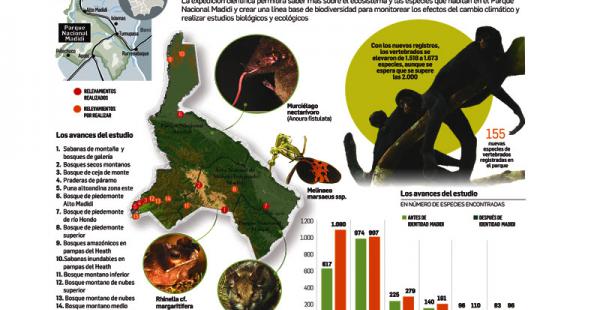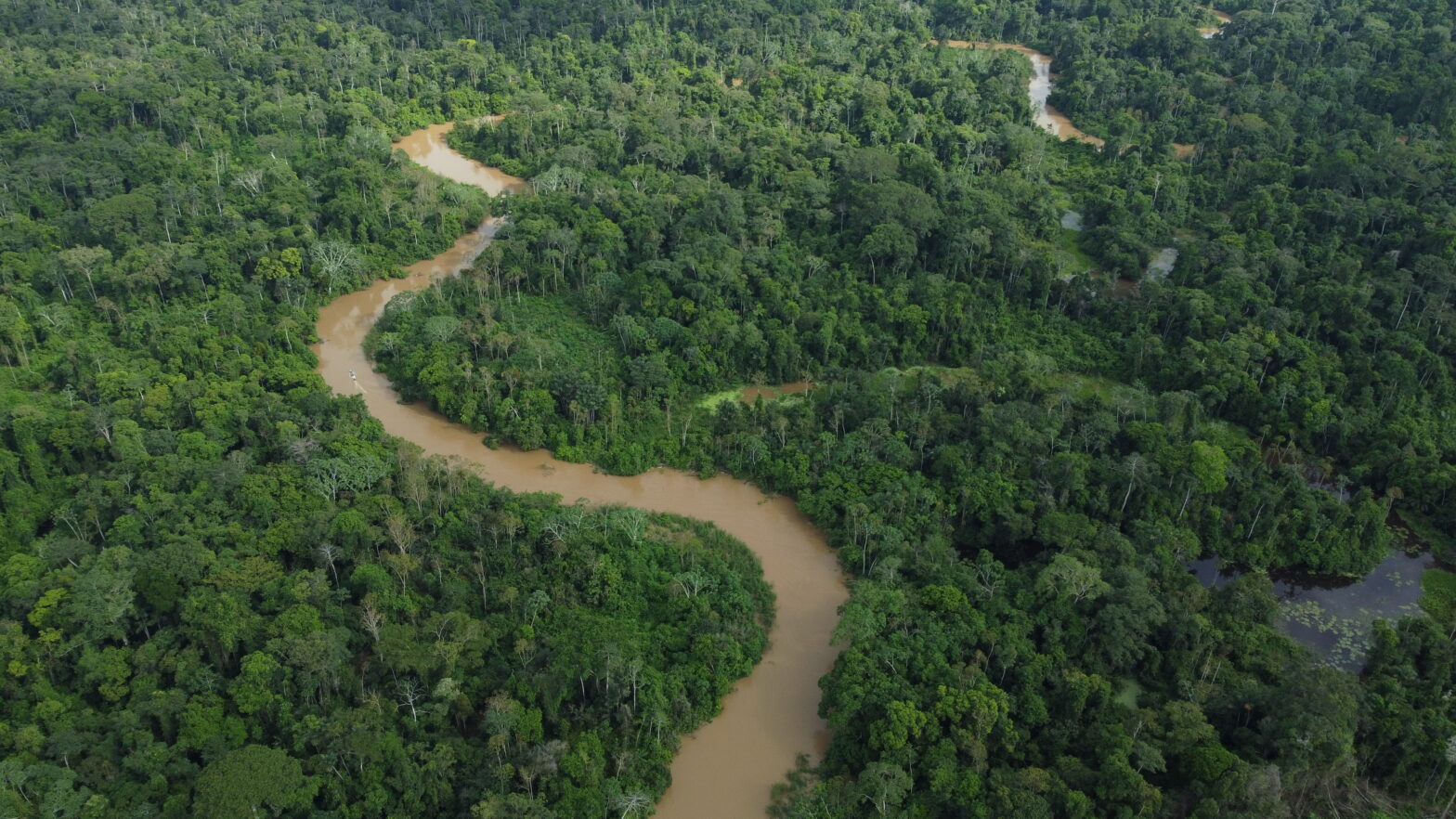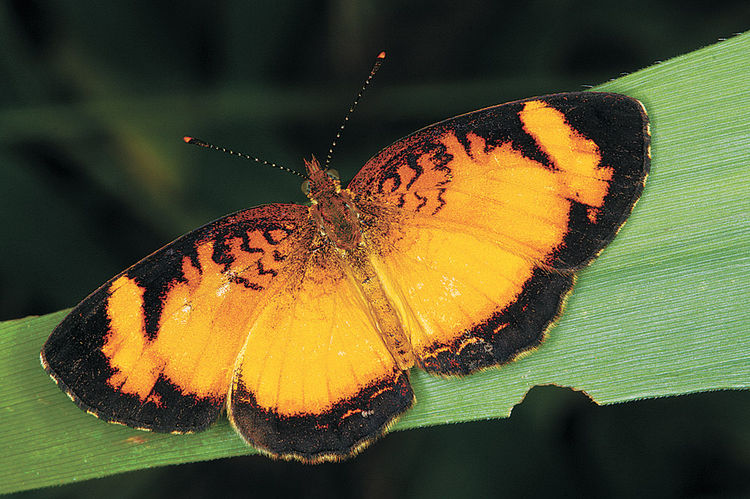ID Madidi will explore 14 sites throughout Madidi National Park over the next year and a half. At their first study site, the researchers found a new species of frog. With two sites under their belt, they’ve recorded 60 vertebrates not known to inhabit the park.
We entered the forest where we left it the night before. Extending in front of us was a long line of translucent plastic sheeting, punctuated every few meters with a stake and a bucket dug into the ground. Small mammal biologist Nuria Bernal Hoverud and her study team worked hard the previous day, laying out the sampling transect in the hopes of catching small mammals in Bolivia’s super-biodiverse Madidi National Park. The transect was so long, I thought there were sure to be loads of exotic mice and other mammals in the buckets the next morning. But here we were, looking into each one in turn, but finding no mammals. Instead, there were spiders – many, many spiders – and in the bottoms of two of the buckets, a couple small brown frogs.
The frogs seemed nondescript and unremarkable, happenstance accidents in the pursuit of something more interesting. But those little brown frogs turned out to be the biggest find of this section of the trip – a new species completely unknown to science. That is, until the Identidad Madidi expedition discovered them on June 7th in a little-explored part of Bolivia.


Identidad Madidi is a major biological expedition happening right now that aims to increase knowledge of the biodiversity of northern Bolivia’s Madidi National Park. The team consists of 30-some biologists and guides who will be surveying Madidi’s plethora of ecosystems over the next year and a half.
I joined them on the first leg of the expedition in June. After landing in El Alto International Airport – the highest international airport in the world – I hopped in a Land Cruiser early on the 5th and away we went through a still-dark La Paz , up over the Altiplano plateau, and down towards the Amazon Basin. Our destination was midway between these two, a transition zone where the Amazon and the Andes meet. Here, the researchers hoped to find species from both areas – and perhaps even some new ones.

Fourteen hours later, much of it spent along a single-lane road carved out of the side of a ravine, we arrived in Apolo. An outpost town of around 2,000, Apolo is the major hub of the region. Surrounded by ranchland, the town is also abutted on three sides by protected areas: Apolobamba National Park to the west and Madidi National Park to the north and east, and Madidi Integrated Management Natural Area (IMNA) where restrictions are more relaxed. After a night at a friendly hostel run by nuns and another hour’s drive, we arrived at basecamp where setup was already underway. Within a few hours everything was assembled, from the sleeping and laboratory tents to the shower station and kitchen shelves.
This first site of the Identidad Madidi expedition is a dramatic landscape dominated by montane pampa grassland. Here, savanna hills rise high and broad from gallery forests, with stark white, angular Brahma cattle scattered across them like piles of old bones. The cattle have been crossbred with Zebu to make them more likely to survive in dry areas, but they still look perpetually undernourished and, according to locals, their skeletons are so brittle that feral herds can’t be lassoed without their necks breaking. The land is still used for ranching in the IMNA and within the national park boundary.
“It’s a great irony,” said Rob Wallace, Director of the Wildlife Conservation Society’s (WCS) Greater Madidi-Tambopata Landscape Conservation Program and leader of the ID Madidi expedition.
According to Wallace, for centuries the region was promoted as a good place to raise cattle because of its grasslands. And, at first glance, it does bear a resemblance to the ranches of the American West, but that’s where the similarity ends. The soil – if you can call it that – is little more than sandstone so soft it crumbles with a touch. Patchy, tough grasses and a dry, native, dome-shaped plant called “wacauma” sparsely cover the ground. Soluble mineral content is low here, prompting a desperation for salt in unadapted cattle. The thirst is so bad, that cattle will chase humans for a lick of their skin, while butterflies—also salt starved – descend in hordes when anything urinates.




To increase soil fertility and encourage new, more nutritious plant growth for their cattle to eat, ranchers burn the pampa. And they burn it often. So often, in fact, that a new fire could be seen somewhere in the valley every day while I was there. How much this has changed the landscape since cattle were introduced to the area has not been studied. But according to William Ferrufino, a guide who has lived in the area his entire life and been active in local conservation efforts for decades, many native pampa plants in the valley are adapted to survive fires. This indicates that it may be, to some degree, a natural burn ecosystem.
However, there is also evidence that humans are changing the region. Data from Global Forest Watch show that a large area dipping into the park, and comprising the first site of the expedition, is devoid of Intact Forest Landscapes (IFLs), and has been since before IFL monitoring began in 2000. Intact Forest Landscapes are areas of primary forest big and undisturbed enough to retain their original levels of biodiversity. Such areas characterize most of Madidi National Park. Satellite imagery shows several parts of this non-IFL portion of the park have large tracts of forest that are continuous with surrounding IFLs. On the ground, a road into the park was obvious, along with several small farms that were grandfathered in when the park was established. And in one area of the survey site, timber was being extracted near the road, which straddles the boundary between the park and the IMNA. Some of this extraction – on the IMNA side – was legal, but trees were also being felled illegally on the national park side of the road. The loggers were targeting tall, straight, old trees with dense, red wood that was unbelievably heavy. The timber was processed by chainsaw into boards and destined to become parquet flooring in La Paz, according to one of the researchers. Ferrufino said several of the felled trees had been more than a hundred years old.



Park rangers were aware of the logging, and we encountered several surveying the site. However, Madidi National Park has only 30 rangers for all of its 7,320 square miles (18,960 square kilometers) – an area larger than the U.S. state of Connecticut – which makes monitoring and enforcement a tricky issue. But despite it all, research indicates that the protections conferred by Madidi’s national park status are working.
Madidi realized
Madidi National Park, named after a local ant species, was created in 1995 to preserve the region’s extraordinarily high levels of biodiversity. Officially, 8,244 plant and 1,466 vertebrate species have been registered in the national park and IMNA, spread out across a dozen types of ecosystems from lowland Amazon rainforest at 180 meters (590 feet) above sea level to snowcapped Andean peaks at 6,040 meters (19,800 feet). Among these are many threatened species, such as the Andean bear, jaguar, giant otter, maned wolf, woolly monkey, Andean condor, and black caiman. Madidi National Park is regarded by scientists as potentially the most biologically-diverse protected area in the world, containing three percent of the planet’s plant species, nearly four percent of its vertebrates, and 11 percent of its birds.
“If you average it out, it’s probably got two-thirds of Bolivia’s biodiversity,” Wallace said.





Designating Madidi as a national park quickly brought measurable benefits to the area’s fauna and flora, according to Wallace. Mahogany logging largely stopped after two years. Jaguar numbers more than quintupled, with camera traps showing densities went from 1-2 jaguars per 100 square kilometers to 8-10 five years later.
“Protected areas do have problems,” Wallace said. “But there’s been a lot of literature recently about how effective protected areas are. The key piece to biodiversity protection is protected areas.”
Madidi National Park and IMNA are also home to 31 indigenous communities of Tacana, Leco, and Quechu ancestry for a total human population of 3,174. In addition to protecting the region’s wealth of wildlife, the park and IMNA safeguard these indigenous communities and promote sustainable natural resource use.
For instance, conservation institutions and local communities around Apolo worked together to promote the sustainable harvesting of incense. Local communities have collected incense for generations by cutting into the bark of certain trees and catching the sap, sort of like how maple syrup is harvested in North America. But cutting too often or too deeply can damage the trees, so it’s important to have a set of rules to go by.
“They develop these regulations themselves,” Wallace said. “They know that if they cut a tree too much, it will die.”



Monitoring is a more challenging task, according to Wallace. To help keep tabs on the health of the forests and the incense trees, WCS and other organizations teamed up with local communities to develop a monitoring rubric for resin harvesters. They were taught how to record the volume of resin collected, the effort spent, and the number of trees used for production. To make sure things go as planned, outside organizations conduct evaluations every few years.
Shade-grown coffee and native cacao are also focal points of WCS’s sustainability programs.
“We’re working with probably 70 communities across the landscape on different issues,” Wallace said.
Despite its biological importance, Madidi National Park has not been extensively surveyed. For example, there exists no biodiversity baseline against which to measure the impacts of climate change on the region’s wildlife. In response to this, Identidad Madidi was developed over the past four years to bring a diverse group of scientists to Madidi’s diverse array of ecosystems and see how many different kinds of animals and plants they could find.
Supported by Bolivia’s National Biodiversity Network, the Ministry of the Environment and Water, and the Vice Ministry of Science and Technology, scientists from institutions and organizations including the National Herbarium,Bolivian Fauna Collection, Institute of Ecology, Armonia, and WCS will travel to 14 poorly explored sites across 5,000 meters in altitude. At these sites they will look for vertebrates using a variety of techniques, from live trapping to camera trapping and from listening for birdcalls to catching bats in nets.


Another goal of Identidad Madidi is to spread awareness of the park’s wildlife – and the country’s wildlife in general – to the Bolivian populace.
“Bolivian citizens are more familiar with polar bears than they are with much of their country’s wildlife,” Wallace said.
To counter this mindset, the ID Madidi team is engaging Bolivian citizens around the country through presentations, social media, newspaper stories, leaflets, blog posts, and other initiatives to teach them about their natural heritage. In particular, they will hold meetings and presentations in the towns near their survey sites with the aim of eliciting community support while furthering locals’ understanding of biology and conservation.
16 days, 208 vertebrates, and a new species
Two days in the field at the first site and the researchers had already found three species that hadn’t before been recorded in Madidi National Park, including the totally new frog.
“This is why I wanted to come here!” yelled Wallace, walking up the path from the river at the end of a long, successful day of looking for animals.


The ID Madidi team chose the area for its uniqueness, thinking the confluence of habitats may drive different types of animals together and perhaps even have inspired unique evolution trajectories of endemic species as-yet unknown to science.
They were right.
By the end of the first week, the study teams had caught 75 different vertebrate species. Three days later, they reached 100. By the last day, due in part to the late addition of an ornithologist, they’d registered 208 vertebrate species, of which 32 hadn’t been recorded in Madidi before. These included several species of catfish new to the park (and possibly new to science), a recently discovered and not-yet-described species of bat with a scalp that detaches from its skull, an Andean bear ambling the hills, a tree rat with furred feet never before trapped so high, and a spotted guinea pig-like mountain paca that had never before been seen so low.





And then there’s the brand new frog. It belongs to the Oreobates genus, which comprises a group of usually brownish frogs found from Colombia to Argentina and west into Brazil. While it took a few weeks to morphologically determine the frog to be a new species, the researchers suspected right away that it might be unique.
“[We] immediately thought it could be a new species because of a very specific characteristic, the inner thigh has an intense orange color that has not been observed for other species of Oreobates in the country,” said herpetologists James Aparicio and Mauricio Ocampo, who initially examined it.
Also, unlike other Oreobates species, this frog lacks wart-like bumps on its heel and its toes are distinctive.
“Comparing these features has allowed us to eliminate as possibilities several already described Oreobates species in Bolivia and neighboring Peru,” they said in a joint communication with Mongabay after the frog had been confirmed as new to science.


This new frog was commonly encountered at the first site, but only in specific kinds of habitat. The researchers speculate it may be restricted to lightly forested savannah ecosystems.
“We could hypothesize that this species is distributed across the montane savannahs of Apolo and their gallery forests,” said Aparicio and Ocampo. “However, other factors such as altitude and rainfall are also important for amphibians and this may vary across that habitat. For the moment we can say that it has a restricted distribution around our first study site.”
The next steps for the frog and its discoverers are genetic analyses to confirm that it is indeed a new species, and then a proper description that the researchers say will likely be published sometime next year.
Onward and upward
As I was leaving the first study site at the end of June to make the long trip back to La Paz, the team was packing up and getting ready for the next site. Everyone had worked hard sunup to sundown over the past 15 days, but the anticipation of exploring somewhere new was palpable. Camp was dismantled as quickly as it had been erected, the insides and tops of the vehicles loaded up with all the gear and people they could carry.

They were headed to “bosco seco,” the dry montane forest just across the Integrated Management Natural Area that splits Madidi National Park. Covering about 1,200 square kilometers, this ecosystem is one of the largest patches of dry forest in the Tropical Andes, and contains its highest levels of biodiversity. Over the next 20 days, the researchers got a taste of that biodiversity – a big taste. The team found 254 vertebrate species, of which 28 were new records for the park.
They even found two little-studied bats, and a few other species that may turn out to be new, as well.
“We did find the suspected new species of spectacled lizard that is probably going to be endemic to that habitat and there are also one or two fish that are candidate new species,” Wallace said.
This week, the team is headed into the high Andes, where they will sample three sites between 3,750 and 5,250 meters in elevation. There, Aparicio thinks they may find lizards from the Liolaemus genus that are specially adapted to live in the cold near glaciers.
Wallace also hopes for a specific mammal.
“Personally I would love to get another look at an Andean cat – yet to be confirmed as present in Madidi,” Wallace said. “From the perspective of the overall Identidad Madidi initiative, the High Andes has been very poorly studied and so even though overall vertebrate diversity is lower than further down the altitudinal gradient, there are lots of species to be confirmed for the park – it would be great if we could get close to a total of 100 new records after these three High Andean sites.”
As of now, the species tally has exceeded the team’s expectations. With just two sites down, they’ve found 30 percent of the entire expedition’s target number of species that are new for Madidi.

“The biggest surprise is how many new records we have been able to amass from just two of the fourteen study sites,” Wallace said. “Before embarking on Identidad Madidi we had set an ambitious target of registering 200 new vertebrates for the park list. We already have 60 and it seems probable that we will need to revise that target.
“Whilst may of those new records were “expected” in the park, a significant number were considered as only “possible” for Madidi, and at least three were not even on the list of possible records list. This further highlights the extraordinary diversity of Madidi, but also emphasizes the need for more biodiversity studies across the Andes-Amazon region.”
– This report was originally published in Mongabay and is republished by an agreement to share content.





